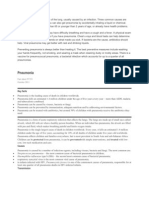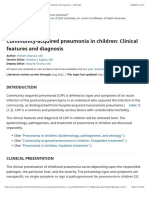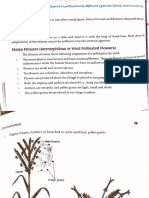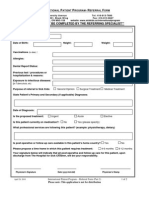0 ratings0% found this document useful (0 votes)
7 viewsPractice Essentials: View Media Gallery
Practice Essentials: View Media Gallery
Uploaded by
Aza Patullah ZaiPediatric pneumonia is responsible for over 800,000 child deaths worldwide each year, mostly in developing countries. Symptoms vary by age but may include cough, fast breathing, and low oxygen levels. Diagnosis involves listening to the chest and potentially other tests. Treatment focuses on respiratory support and antibiotics like amoxicillin depending on severity and suspected germ.
Copyright:
© All Rights Reserved
Available Formats
Download as DOCX, PDF, TXT or read online from Scribd
Practice Essentials: View Media Gallery
Practice Essentials: View Media Gallery
Uploaded by
Aza Patullah Zai0 ratings0% found this document useful (0 votes)
7 views3 pagesPediatric pneumonia is responsible for over 800,000 child deaths worldwide each year, mostly in developing countries. Symptoms vary by age but may include cough, fast breathing, and low oxygen levels. Diagnosis involves listening to the chest and potentially other tests. Treatment focuses on respiratory support and antibiotics like amoxicillin depending on severity and suspected germ.
Original Title
Pediatric Pneumonia
Copyright
© © All Rights Reserved
Available Formats
DOCX, PDF, TXT or read online from Scribd
Share this document
Did you find this document useful?
Is this content inappropriate?
Pediatric pneumonia is responsible for over 800,000 child deaths worldwide each year, mostly in developing countries. Symptoms vary by age but may include cough, fast breathing, and low oxygen levels. Diagnosis involves listening to the chest and potentially other tests. Treatment focuses on respiratory support and antibiotics like amoxicillin depending on severity and suspected germ.
Copyright:
© All Rights Reserved
Available Formats
Download as DOCX, PDF, TXT or read online from Scribd
Download as docx, pdf, or txt
0 ratings0% found this document useful (0 votes)
7 views3 pagesPractice Essentials: View Media Gallery
Practice Essentials: View Media Gallery
Uploaded by
Aza Patullah ZaiPediatric pneumonia is responsible for over 800,000 child deaths worldwide each year, mostly in developing countries. Symptoms vary by age but may include cough, fast breathing, and low oxygen levels. Diagnosis involves listening to the chest and potentially other tests. Treatment focuses on respiratory support and antibiotics like amoxicillin depending on severity and suspected germ.
Copyright:
© All Rights Reserved
Available Formats
Download as DOCX, PDF, TXT or read online from Scribd
Download as docx, pdf, or txt
You are on page 1of 3
Practice Essentials
Pediatric pneumonia is responsible for the deaths of more than 800,000
young children worldwide each year, according to the United Nations
Children's Fund (UNICEF). [1] These deaths occur almost exclusively in
children with underlying conditions, such as chronic lung disease of
prematurity, congenital heart disease, and immunosuppression. Although
most fatalities occur in developing countries, pneumonia (see the image
below) remains a significant cause of morbidity in industrialized nations.
Right lower lobe consolidation
in a patient with bacterial pneumonia.
View Media Gallery
Signs and symptoms
Pneumonia can occur at any age; nevertheless, it is more common in
younger children. Pneumonia accounts for 13% of all infectious illnesses in
infants younger than 2 years of age.
Newborns with pneumonia commonly present with poor feeding and
irritability, as well as tachypnea, retractions, grunting, and hypoxemia.
Infections with group B Streptococcus, Listeria monocytogenes, or gram-
negative rods (eg, Escherichia coli, Klebsiella pneumoniae) are common
causes of bacterial pneumonia. Group B streptococci infections are most
often transmitted to the fetus in utero. The most commonly isolated virus is
respiratory syncytial virus (RSV).
Cough is the most common symptom of pneumonia in infants, along with
tachypnea, retractions, and hypoxemia. These may be accompanied by
congestion, fever, irritability, and decreased feeding. Viruses are the most
common cause of pediatric pneumonia. Streptococcus pneumoniae is the
most common bacterial pathogen in infants aged 1-3 months.
Adolescents experience symptoms similar to those in younger children.
They may have other constitutional symptoms, such as headache, pleuritic
chest pain, and nonspecific abdominal pain. Mycoplasma pneumoniae is
the most frequent cause of pneumonia among older children and
adolescents.
See Clinical Presentation for more detail.
Diagnosis
The signs and symptoms of pneumonia are often nonspecific
and vary widely based on the child's age and the infectious organisms
involved.
Observing the child’s respiratory effort during a physical examination is an
important first step in diagnosing pneumonia. The World Health
Organization (WHO) respiratory rate thresholds for identifying children with
pneumonia are as follows:
Children younger than 2 months: Greater than or equal to 60
breaths/min
Children aged 2-12 months: Greater than or equal to 50
breaths/min
Children aged 1-5 years: Greater than or equal to 40 breaths/min
Be aware that the WHO definition requires only cough and tachypnea on
physical examination. [2]
Assessment of oxygen saturation by pulse oximetry should be performed
early in the evaluation when respiratory symptoms are present. Cyanosis
may be present in severe cases. Capnography may be useful in the
evaluation of children with potential respiratory compromise.
Other diagnostic tests may include the following:
Auscultation by stethoscope
Cultures
Serology
Complete blood cell count (CBC)
Chest radiography
Ultrasonography
Current data show that point-of-care ultrasonography helps accurately
diagnose most cases of pneumonia in children and young adults.
Ultrasonography may eventually replace radiographs for diagnosis. [3]
See Workup for more detail.
Management
Initial priorities in children with pneumonia include the identification and
treatment of respiratory distress, hypoxemia, and hypercarbia. Grunting,
flaring, severe tachypnea, and retractions should prompt immediate
respiratory support. Children who are in severe respiratory distress should
undergo tracheal intubation if they are unable to maintain oxygenation or
have decreasing levels of consciousness. Increased respiratory support
requirements such as increased inhaled oxygen concentration, positive
pressure ventilation, or continuous positive airway pressure (CPAP) are
commonly required before recovery begins.
Antibiotics
The majority of children diagnosed with pneumonia in the outpatient setting
are treated with oral antibiotics. High-dose amoxicillin is the agent of choice
for children with uncomplicated community-acquired pneumonia. Second-
or third-generation cephalosporins and macrolide antibiotics such as
azithromycin are acceptable alternatives. Combination therapy (ampicillin
and either gentamicin or cefotaxime) is typically used in the initial treatment
of newborns and young infants.
Hospitalized patients can also usually be treated with a narrow-spectrum
penicillin such as ampicillin. The choice of agent and dosing may vary
based on local resistance rates (high rates of intermediate or resistant
pneumococcus may require higher dosing of ampicillin to surmount the
altered penicillin-binding protein that is the cause of resistant
pneumococcus). In areas where resistance is very high (>25% of strains
being nonsusceptible), a third-generation cephalosporin might be indicated
instead. In addition, older children may receive a macrolide to cover for
atypical infections.
Although the fluoroquinolones would cover all the common respiratory
pathogens of childhood, they are not approved for this indication and have
significant potential adverse effects, including short-term tendon damage
and long-term impact on antibiotic resistance. They should be reserved for
cases in which other therapies have failed and ideally should be used after
consultation with an infectious disease specialist with whom other options,
or alternative diagnoses, can be considered.
Children who are toxic appearing should receive antibiotic therapy that
includes vancomycin (particularly in areas where penicillin-resistant
pneumococci and methicillin-resistant Staphylococcus aureus [MRSA] are
prevalent) along with a second- or third-generation cephalosporin.
Vaccines
Aside from avoiding infectious contacts (difficult for many families who use
daycare facilities), vaccination is the primary mode of prevention. Influenza
vaccine is recommended for children aged 6 months and older. The
pneumococcal conjugate vaccine (PCV13) is recommended for all children
younger than 59 months of age. The 23-valent polysaccharide vaccine
(PPV23) is recommended for children aged 24 months and older who are
at high risk for pneumococcal disease.
See Treatment and Medication for more detail.
You might also like
- A Technical Report On ITDocument34 pagesA Technical Report On ITFeddy Micheal FeddyNo ratings yet
- Case Ana Neonatal PneuDocument2 pagesCase Ana Neonatal PneuCharmie GandaNo ratings yet
- Copyreading Exercises EnglishDocument35 pagesCopyreading Exercises EnglishReyshanne Joy B Marquez100% (3)
- Essential Update: Pediatric Pneumonia May Be Effectively Treated With Twice-Daily AmoxicillinDocument54 pagesEssential Update: Pediatric Pneumonia May Be Effectively Treated With Twice-Daily AmoxicillinYostesara Maurena SantosaNo ratings yet
- Pediatric PneumoniaDocument12 pagesPediatric PneumoniaKrystal Migo Denolo ContrerasNo ratings yet
- Practice Essentials: Pediatric Pneumonia MedicationDocument56 pagesPractice Essentials: Pediatric Pneumonia MedicationAnonymous HgX3mN1oNo ratings yet
- Listeria Monocytogenes Escherichia Coli: Signs and SymptomsDocument15 pagesListeria Monocytogenes Escherichia Coli: Signs and SymptomsPuput's BourboneNo ratings yet
- Growth Chest InfectionsDocument18 pagesGrowth Chest InfectionsjibiannieNo ratings yet
- Pneumonia: Key FactsDocument28 pagesPneumonia: Key FactsAri Widiastuti NiPutuNo ratings yet
- PneumoniaDocument8 pagesPneumoniaPratiwi RukmanaNo ratings yet
- Chapter 3Document11 pagesChapter 3Fariz HidayatNo ratings yet
- Updated September 2016: PneumoniaDocument5 pagesUpdated September 2016: PneumoniaYidnekachew Girma Assefa100% (1)
- Case Study PcapDocument3 pagesCase Study PcapClaire PalaciosNo ratings yet
- Pediatric Community-Acquired Pneumonia: Nelson 20 EdDocument43 pagesPediatric Community-Acquired Pneumonia: Nelson 20 EdRazel Kinette AzotesNo ratings yet
- Community-Acquired Pneumonia in Infants and ChildrenDocument9 pagesCommunity-Acquired Pneumonia in Infants and ChildrenLorenn AdarnaNo ratings yet
- Infectious Pediatric Pneumonia: Author: Roberta D. Hood, HBSC, MD, CCFP Date Created: December 2011Document137 pagesInfectious Pediatric Pneumonia: Author: Roberta D. Hood, HBSC, MD, CCFP Date Created: December 2011Kartika Rezky100% (1)
- 2002 23 132 Benjamin Gaston: Pediatr. RevDocument11 pages2002 23 132 Benjamin Gaston: Pediatr. RevDiego DíazNo ratings yet
- Ncbi - Nlm.nih - Gov-Pediatric PneumoniaDocument10 pagesNcbi - Nlm.nih - Gov-Pediatric Pneumoniako naythweNo ratings yet
- Pediatric Lower Respiratory Tract InfectionsDocument18 pagesPediatric Lower Respiratory Tract InfectionsSasa AbassNo ratings yet
- Proposal To Include Antibacterial Drugs For Treating Upper and Lower Respiratory Infections in ChildrenDocument52 pagesProposal To Include Antibacterial Drugs For Treating Upper and Lower Respiratory Infections in ChildrenAznil FajriNo ratings yet
- Lower Respiratory Tract Infections in ChildrenDocument18 pagesLower Respiratory Tract Infections in ChildrenAmani HamoodNo ratings yet
- Pediatric Pneumonia - Practice Essentials, Background, PathophysiologyDocument1 pagePediatric Pneumonia - Practice Essentials, Background, PathophysiologyShiferaw TesfayeNo ratings yet
- Bronchiolitis: Juan Manuel LozanoDocument18 pagesBronchiolitis: Juan Manuel LozanoFelipe CamposNo ratings yet
- The Wheezing Infant: Airway Problems in ChildrenDocument4 pagesThe Wheezing Infant: Airway Problems in ChildrenDenise DelaneyNo ratings yet
- Respiratory SystemDocument30 pagesRespiratory SystemHani El-asferNo ratings yet
- Case Study PneumoniaDocument53 pagesCase Study PneumoniaWilliam Agoncillo100% (1)
- Severe Asthma ChildrenDocument4 pagesSevere Asthma ChildreneddcitoNo ratings yet
- Recurrent PneumoniaDocument12 pagesRecurrent Pneumoniabustillojosh367No ratings yet
- Asthma: A. Practice EssentialsDocument8 pagesAsthma: A. Practice EssentialsCandha NurcahyaNo ratings yet
- BPJ 45 Pneumonia Pages 25-29Document5 pagesBPJ 45 Pneumonia Pages 25-29Sharon AldaveNo ratings yet
- Addis Ababa University: Collage of Health Science Pediatrics and Neonatology On PneumoniaDocument21 pagesAddis Ababa University: Collage of Health Science Pediatrics and Neonatology On PneumoniaCheru Dugase100% (1)
- Community-Acquired Pneumonia in Children - Outpatient Treatment - UpToDateDocument38 pagesCommunity-Acquired Pneumonia in Children - Outpatient Treatment - UpToDateJosué Pablo Chicaiza AbadNo ratings yet
- Epidemiology of TBDocument4 pagesEpidemiology of TByam pdNo ratings yet
- Paul Christian C. Paragas March 15, 2013 BSN - MSC Mrs. Maridel M. Juarez Pneumonia Updates Key FactsDocument3 pagesPaul Christian C. Paragas March 15, 2013 BSN - MSC Mrs. Maridel M. Juarez Pneumonia Updates Key FactsMichael UrrutiaNo ratings yet
- Case On PcapDocument1 pageCase On PcapLorenn AdarnaNo ratings yet
- Pneumonia Is An Inflammation of The LungDocument3 pagesPneumonia Is An Inflammation of The LungDoubleHeartedNo ratings yet
- Community Acquired Pneumonia, A Case StudyDocument26 pagesCommunity Acquired Pneumonia, A Case StudyMenggay SanDiego67% (9)
- Act (2) UNIDAD I.JoseVenturayElianaMedinaDocument5 pagesAct (2) UNIDAD I.JoseVenturayElianaMedinaEliana MedinaNo ratings yet
- Nursing Care Management 103 Cap MRDocument9 pagesNursing Care Management 103 Cap MRkarenfaye00No ratings yet
- Community-Acquired Pneumonia in Children - Outpatient Treatment - UpToDateDocument34 pagesCommunity-Acquired Pneumonia in Children - Outpatient Treatment - UpToDatekarla perezNo ratings yet
- 01 ProjectDocument30 pages01 Projectkarunyabathula100% (1)
- PediatricpneumoniaDocument29 pagesPediatricpneumoniaNur NurhasyanahNo ratings yet
- Oleh: Ns. Hana Ariyani, M. KepDocument23 pagesOleh: Ns. Hana Ariyani, M. KepMuhammad Rizal alimuddinNo ratings yet
- BronchioitisDocument24 pagesBronchioitismitiku aberaNo ratings yet
- Community-Acquired Pneumonia in Children - Clinical Features and Diagnosis - UpToDateDocument48 pagesCommunity-Acquired Pneumonia in Children - Clinical Features and Diagnosis - UpToDateAlejandra AubadNo ratings yet
- PDF DocumentDocument44 pagesPDF DocumentBintangemonNo ratings yet
- Community-Acquired Pneumonia in Children - Outpatient TreatmentDocument33 pagesCommunity-Acquired Pneumonia in Children - Outpatient Treatmentmayteveronica1000No ratings yet
- Pneumonia in ChildrenDocument28 pagesPneumonia in Childrenvyjxsk6rfgNo ratings yet
- Wheez ChestDocument12 pagesWheez ChestmelisaberlianNo ratings yet
- Pneumonia: Practice GapDocument21 pagesPneumonia: Practice GaptamaNo ratings yet
- 18 UpToDate NeumoníaDocument113 pages18 UpToDate NeumoníaAl DavisNo ratings yet
- Pneumonia 1Document17 pagesPneumonia 1Jonathan katanaNo ratings yet
- Community-Acquired Pneumonia in Children: Clinical Features and Diagnosis - UpToDateDocument62 pagesCommunity-Acquired Pneumonia in Children: Clinical Features and Diagnosis - UpToDateYeidhy Karin Cayo CoñezNo ratings yet
- Pneumonias in Children Practical Policies For StudentsDocument45 pagesPneumonias in Children Practical Policies For StudentsIbtissame BadadNo ratings yet
- Community-Acquired Pneumonia in Children - Clinical Features and DiagnosisDocument57 pagesCommunity-Acquired Pneumonia in Children - Clinical Features and Diagnosismayteveronica1000No ratings yet
- Chapter VI.11. Pulmonary Infections: Case Based Pediatrics For Medical Students and ResidentsDocument8 pagesChapter VI.11. Pulmonary Infections: Case Based Pediatrics For Medical Students and ResidentsصثقيفبلغاعNo ratings yet
- PCAP HandoutDocument1 pagePCAP HandoutCherr NollNo ratings yet
- Diagnosis and Treatment of Chronic CoughFrom EverandDiagnosis and Treatment of Chronic CoughSang Heon ChoNo ratings yet
- Neonatal and Pediatric Respiratory Care for Healthcare ProvidersFrom EverandNeonatal and Pediatric Respiratory Care for Healthcare ProvidersNo ratings yet
- Whooping Cough Unveiled: From Pathogenesis to Promising TherapiesFrom EverandWhooping Cough Unveiled: From Pathogenesis to Promising TherapiesNo ratings yet
- Sckkeriis Baru XobaDocument4 pagesSckkeriis Baru XobaAza Patullah ZaiNo ratings yet
- Bakterial KeratitisDocument3 pagesBakterial KeratitisAza Patullah ZaiNo ratings yet
- S JorgenDocument2 pagesS JorgenAza Patullah ZaiNo ratings yet
- Background: Bacterial Keratitis Corneal Ulcers in Emergency SettingsDocument3 pagesBackground: Bacterial Keratitis Corneal Ulcers in Emergency SettingsAza Patullah ZaiNo ratings yet
- Sckkeriis BaruDocument2 pagesSckkeriis BaruAza Patullah ZaiNo ratings yet
- Immitis, Blastomyces Dermatitidis, Paracoccidioides Brasiliensis, Sporothrix Schenckii, Cryptococcus Neoformans) Cause Infection in Healthy Hosts andDocument2 pagesImmitis, Blastomyces Dermatitidis, Paracoccidioides Brasiliensis, Sporothrix Schenckii, Cryptococcus Neoformans) Cause Infection in Healthy Hosts andAza Patullah ZaiNo ratings yet
- Aspiration Pneumonitis and PneumoniaDocument2 pagesAspiration Pneumonitis and PneumoniaAza Patullah ZaiNo ratings yet
- Atypical Bacterial Pneumonia ImagingDocument3 pagesAtypical Bacterial Pneumonia ImagingAza Patullah ZaiNo ratings yet
- Background: Pneumonia, Pediatric Afebrile Pneumonia SyndromeDocument1 pageBackground: Pneumonia, Pediatric Afebrile Pneumonia SyndromeAza Patullah ZaiNo ratings yet
- Pneumonia Risk Soars in Heart Failure Patients, Especially HFpEFDocument2 pagesPneumonia Risk Soars in Heart Failure Patients, Especially HFpEFAza Patullah ZaiNo ratings yet
- Pneumonia in Immunocompromised PatientsDocument2 pagesPneumonia in Immunocompromised PatientsAza Patullah ZaiNo ratings yet
- Postterm PregnancyDocument9 pagesPostterm PregnancyAza Patullah ZaiNo ratings yet
- Ventilator-Associated Pneumonia Overview of Nosocomial PneumoniasDocument11 pagesVentilator-Associated Pneumonia Overview of Nosocomial PneumoniasAza Patullah ZaiNo ratings yet
- Polymorphic Eruption of PregnancyDocument2 pagesPolymorphic Eruption of PregnancyAza Patullah ZaiNo ratings yet
- Hospital-Acquired Pneumonia (Nosocomial Pneumonia) and Ventilator-Associated PneumoniaDocument17 pagesHospital-Acquired Pneumonia (Nosocomial Pneumonia) and Ventilator-Associated PneumoniaAza Patullah ZaiNo ratings yet
- Physiology of OvulationDocument7 pagesPhysiology of OvulationAza Patullah ZaiNo ratings yet
- Pneumonia Is An InfectionDocument5 pagesPneumonia Is An InfectionAza Patullah ZaiNo ratings yet
- Progress Test 2 Microbiology FINALDocument20 pagesProgress Test 2 Microbiology FINALParsa PartoNo ratings yet
- COVID-19 Outbreak Pathogenesis, Current Therapies, and Potentials For Future ManagementDocument25 pagesCOVID-19 Outbreak Pathogenesis, Current Therapies, and Potentials For Future ManagementAgung SentosaNo ratings yet
- BioStat NotesDocument10 pagesBioStat NotesLouisse Alessandra Paderna-DecalNo ratings yet
- The Bodys Defence - MechanismDocument74 pagesThe Bodys Defence - Mechanismagarwaljenish2005No ratings yet
- Scabies: Prevention and Treatment: Public Health Fact SheetDocument2 pagesScabies: Prevention and Treatment: Public Health Fact SheetRebecca BlackburnNo ratings yet
- Microbial Associations/Interactio NS: Nanette Ramilo-Cruz, MD, DPAFPDocument50 pagesMicrobial Associations/Interactio NS: Nanette Ramilo-Cruz, MD, DPAFPKhatrinaNo ratings yet
- CSF SamplesDocument14 pagesCSF SamplesEPHANTUS WAINAINANo ratings yet
- Lesy 102Document30 pagesLesy 102Romano VieiraNo ratings yet
- Ospe ParasitologyDocument19 pagesOspe Parasitologyaimi Batrisyia100% (2)
- Module 9 - Nematodes Part 3Document50 pagesModule 9 - Nematodes Part 3Arnold GarcinesNo ratings yet
- Hand Hygiene Why How and When BrochureDocument7 pagesHand Hygiene Why How and When BrochureWill JoshNo ratings yet
- Bvblue Test For Diagnosis of Bacterial Vaginosis: Linda Myziuk, Barbara Romanowski, and Stephen C. JohnsonDocument4 pagesBvblue Test For Diagnosis of Bacterial Vaginosis: Linda Myziuk, Barbara Romanowski, and Stephen C. JohnsonPiEI20tAkUNo ratings yet
- Spotting Experiments Class 12Document21 pagesSpotting Experiments Class 12Ridyangam Dubey100% (3)
- Scrub Typhus and Leishmaniasis (Kala Azar)Document41 pagesScrub Typhus and Leishmaniasis (Kala Azar)madhusudan swarnkarNo ratings yet
- Tonsillitis and AdenoiditisDocument12 pagesTonsillitis and AdenoiditisHannah Angelu CabadingNo ratings yet
- Employee Health Policy TemplateDocument4 pagesEmployee Health Policy Templatebromberg.alexaNo ratings yet
- Lenz 2015Document18 pagesLenz 2015Hasana Kushadi RatnasariNo ratings yet
- MM6114 EbookDocument16 pagesMM6114 EbookErika Check HaydenNo ratings yet
- Pillar6 Summarizer MrunalPCB11@JustupscpyqDocument33 pagesPillar6 Summarizer MrunalPCB11@JustupscpyqVishwas VsNo ratings yet
- International Patient Referral - Part 2 - Revised - 29-04-2010 - 2Document2 pagesInternational Patient Referral - Part 2 - Revised - 29-04-2010 - 2Fatah AssadNo ratings yet
- PAS X Ganjil 2023Document14 pagesPAS X Ganjil 2023Fida NafiNo ratings yet
- Kopila Registration Forms-Jan2024Document4 pagesKopila Registration Forms-Jan2024Roshan KarnaNo ratings yet
- 3 MicroDocument4 pages3 MicroDumitraNo ratings yet
- BrucellosisDocument36 pagesBrucellosisabel semuNo ratings yet
- Anthrax in Humans and Animals WhoDocument219 pagesAnthrax in Humans and Animals WhoRoshni Agarwal100% (1)
- Acceptance of COVID-19 Vaccine Booster Doses Among BS Nursing Students of DMC College Foundation, Inc.Document77 pagesAcceptance of COVID-19 Vaccine Booster Doses Among BS Nursing Students of DMC College Foundation, Inc.John Del YuntingNo ratings yet
- EpiDocument5 pagesEpiMarie Dinah SalvinoNo ratings yet
- Piat Is A 4th C-WPS OfficeDocument5 pagesPiat Is A 4th C-WPS OfficeJake Angelo TrinidadNo ratings yet










































































































